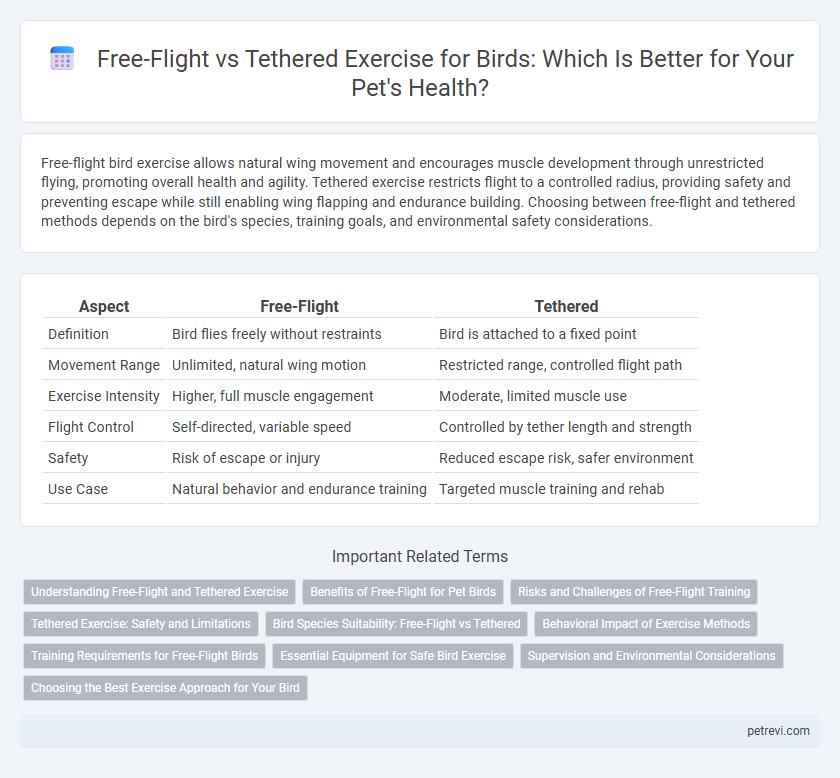Free-flight bird exercise allows natural wing movement and encourages muscle development through unrestricted flying, promoting overall health and agility. Tethered exercise restricts flight to a controlled radius, providing safety and preventing escape while still enabling wing flapping and endurance building. Choosing between free-flight and tethered methods depends on the bird's species, training goals, and environmental safety considerations.
Table of Comparison
| Aspect | Free-Flight | Tethered |
|---|---|---|
| Definition | Bird flies freely without restraints | Bird is attached to a fixed point |
| Movement Range | Unlimited, natural wing motion | Restricted range, controlled flight path |
| Exercise Intensity | Higher, full muscle engagement | Moderate, limited muscle use |
| Flight Control | Self-directed, variable speed | Controlled by tether length and strength |
| Safety | Risk of escape or injury | Reduced escape risk, safer environment |
| Use Case | Natural behavior and endurance training | Targeted muscle training and rehab |
Understanding Free-Flight and Tethered Exercise
Free-flight exercise enables birds to move naturally through open space, enhancing muscle strength and coordination without restraint. Tethered exercise involves securing the bird to a stationary point, which allows for controlled movement and targeted muscle conditioning. Understanding these methods helps optimize bird fitness and prevents injury by balancing freedom with safety.
Benefits of Free-Flight for Pet Birds
Free-flight exercises provide pet birds with enhanced physical health by promoting muscle development and cardiovascular strength through unrestricted movement. This type of flight stimulates natural behaviors and mental enrichment, reducing stress and preventing boredom. Allowing birds to fly freely also improves their coordination and spatial awareness, leading to overall well-being.
Risks and Challenges of Free-Flight Training
Free-flight training poses risks such as unpredictable environmental conditions, increased potential for injury due to uncontrolled flight patterns, and difficulty in monitoring bird behavior continuously. The lack of physical restraints can lead to challenges in ensuring bird safety and managing escape incidents, making it harder to analyze performance data in real-time. These factors require careful planning and advanced tracking technology to mitigate risks effectively.
Tethered Exercise: Safety and Limitations
Tethered exercise for birds offers controlled movement that significantly reduces the risk of injury or escape, making it a safer option for training and rehabilitation. However, tethering limits natural flight dynamics and freedom of movement, which can affect muscle development and mental stimulation compared to free-flight exercises. Proper use of tethers requires careful attention to equipment fit and session duration to prevent stress and physical strain on the bird.
Bird Species Suitability: Free-Flight vs Tethered
Free-flight exercises are best suited for bird species with strong flying capabilities and natural instinct for long-distance movement, such as hawks, falcons, and parrots. Tethered exercises are preferable for smaller or less flight-oriented species like pigeons and canaries, as they offer controlled movement and reduce risk of injury. Selecting the appropriate training method enhances bird health, flight proficiency, and species-specific behavioral development.
Behavioral Impact of Exercise Methods
Free-flight exercises allow birds to engage in natural flying behaviors, promoting muscle development, cognitive stimulation, and stress reduction. Tethered exercise limits movement, potentially leading to frustration, decreased motivation, and altered social interactions. Behavioral studies show free-flight improves overall well-being and encourages natural instincts, while tethered methods may impede behavioral expression.
Training Requirements for Free-Flight Birds
Training requirements for free-flight birds emphasize gradual habituation to open spaces to build confidence and navigational skills. Birds undergo flight conditioning sessions that increase duration and complexity, ensuring muscle strength and endurance necessary for sustained flight. Positive reinforcement techniques and consistent recall training are critical for maintaining control and safety during free-flight exercises.
Essential Equipment for Safe Bird Exercise
Essential equipment for safe bird exercise includes secure, well-fitted harnesses designed for comfort and freedom of movement during free-flight sessions. Tethered exercises require durable, lightweight tethers that allow natural wing extension while preventing escape or injury. Both methods benefit from protective aviary goggles and perch accessories that promote safety and mental stimulation.
Supervision and Environmental Considerations
Free-flight bird exercises require constant supervision to ensure safety from predators, hazards, and environmental dangers, emphasizing the need for skilled handlers to monitor behavior and flight paths closely. Tethered exercises limit movement, reducing risks of injury and loss while providing controlled exposure to environmental stimuli such as wind and temperature variations. Environmental factors like weather conditions, habitat complexity, and local predator presence are crucial in determining the appropriate training method and level of supervision necessary for bird welfare and effective exercise.
Choosing the Best Exercise Approach for Your Bird
Selecting between free-flight and tethered exercises depends on your bird's species, behavior, and safety requirements. Free-flight allows natural movement and mental stimulation but requires a secure, controlled environment to prevent accidents or escapes. Tethered exercise offers controlled activity and protection but may limit freedom and physical benefits compared to unrestricted flight.
Free-flight vs Tethered for Bird exercise Infographic

 petrevi.com
petrevi.com